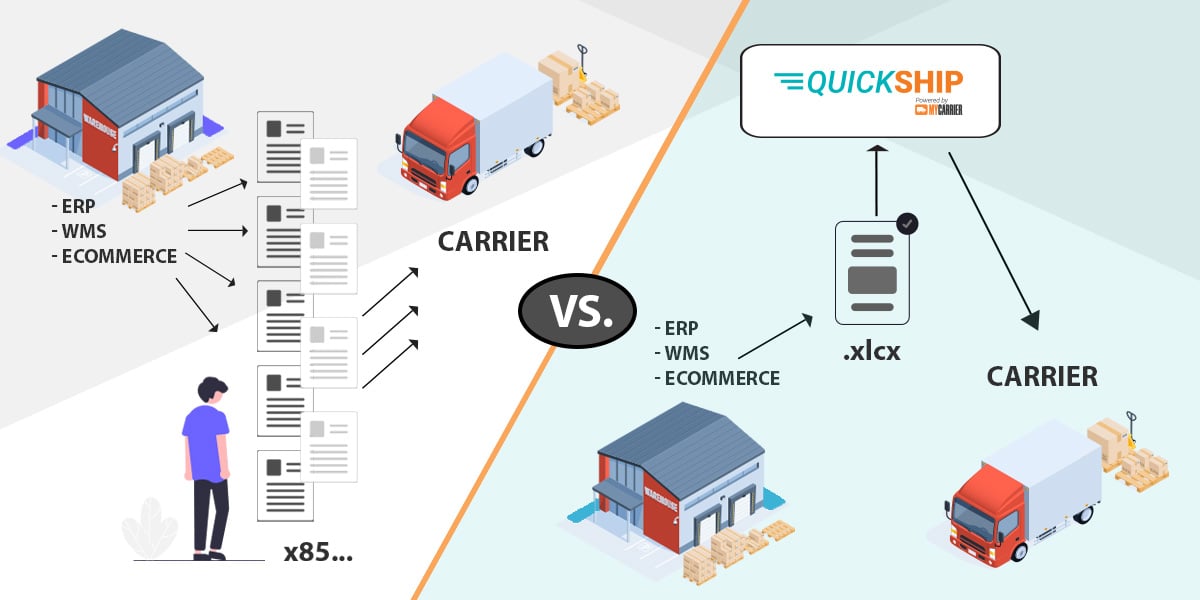- Article -
How LTL Shippers Dispatch Hundreds of Shipments in Minutes
Less than Truckload (LTL) shipping has relied on the same manual, paper-based processes for decades. Today, more than 85% of all LTL shipments still utilize printed forms on both the shipper and the carrier side. With growing pressure for quicker shipments in tight delivery windows, hand-drawn paperwork becomes a critical break in supply chain efficiency when repetitive, manual work opens the door to shipping errors.
Even with sophisticated Enterprise Resource Planning (ERP), Warehouse Management Systems (WMS) and eCommerce tools in place to efficiently manage inventory and stock, many shippers will still encounter the critical break the second it comes to fulfilling LTL-sized orders from their customers.
For many shippers, there is simply no connection between their existing system that records inventory properties like weight and size (ERP, WMS or eCommerce) to the carriers’ systems that return rates based on these properties. This gap is made wider when a single day of business activity can generate dozens of individual LTL orders, each order requiring repetitive manual data entry.
“[It takes] two minutes to create each order. With 50 orders per day, that really ads up,” said Joanna Ross, a Logistics Coordinator at Omni Specialty Packaging LLC.

The most surprising part of this problem is that the technology to bridge the gap between ERP and carrier systems already exists. Transportation-specific Applied Programming Interfaces (APIs) — software that automatically translates data between two programs or systems — have been on the rise for some time now, but adoption by the LTL industry has been slow. Why?
To start, data between supply chain software is not always standardized, meaning an API must be custom-built — a costly option for many small-batch manufacturers and other warehouses who utilize LTL. Moreover, the job of an LTL shipper adds a layer of operational complexity. Logistics coordinators and warehouse managers will create their own in-house solutions to solve LTL needs, often designing their own processes and relationships that are even more difficult standardize or pass on.
While LTL’s API adoption barriers are legitimate business problems, market pressures continue. Even during the pandemic, consumers’ average acceptable delivery time shrunk to 4.5 days max. As the demand for goods continues to heat up in Q3 and Q4 of 2021, LTL shippers cannot afford to wait any longer to fix this efficiency issue if their companies want to remain competitive in the global economic rebound.
QuickShip by MyCarrier is a solution that meets LTL shippers where they are today — at the intersection of operational constraints and unwavering demand for increased efficiency. It works like this.
Any enterprise system managing inventory levels or customer orders includes some type of data export feature, usually in the form of a spreadsheet (.XLSX or .CSV). QuickShip allows shippers to upload those data exports from ERP, WMS or eCommerce directly to MyCarrier. QuickShip will then read the uploaded file for critical cargo details and rate, dispatch, track and deliver a bulk set of orders from this data in seconds.
“By automatically translating a bulk set of order data, QuickShip works like a one-way, wide-lane data bridge,” said Michael Whitmire, VP of marketing. “We’re reducing the number of manual actions from dozens of data entry assignments to a single upload.”
Rather than leaning on the typing skills of a logistics specialist or manager to increase efficiency, QuickShip users can adopt a single task that combines dozens of actions into one.
As the demand for efficiency continues to weigh heavy on the LTL market, MyCarrier remains committed to creating solutions like QuickShip that meet logistics professionals where they are today. Carriers and LTL shippers alike soon can expect direct ERP, WMS and eCommerce integrations from MyCarrier that are easy and cost-effective to implement.


